In her TED talk “The Danger of a Single Story”, Chimamanda Adichie states that “Our lives, our cultures, are composed of many overlapping stories” and “that if we hear only a single story about another person or country, we risk a critical misunderstanding”. This statement has been my inspiration and guide for understanding people of different backgrounds, different dispositions, and different professions. So, when the prospect of this Austin based project first unfolded, I knew that I wanted to tackle something that was universal in our society to receive a negative reputation due to one-sided arguments. What I found was this: funerals, mortuaries, and burials are often considered topics to ignore due to the uncertainty, sadness, and fear that death brings; therefore, I decided to focus my documentary project on professions surrounding funeral services. The reason being is that I would like to reinforce a truth that is often ignored because of the overwhelmingly negative connotations that surround death: these businesses are places of healing, compassion, and support for grieving loved ones, and the people behind them are knowledgeable in skill and driven by a selfless will to comfort others in their time of need.
To conduct this project, I interviewed and photographed morticians from King-Tears Mortuary and Austin Natural Funerals in order to shine a light on the people who work with the families of the deceased and the deceased themselves. My purpose for this is to tell their stories and communicate how they feel. I also visited Eloise Woods Natural Burial Park to research a growing environmental option in funeral services.
-
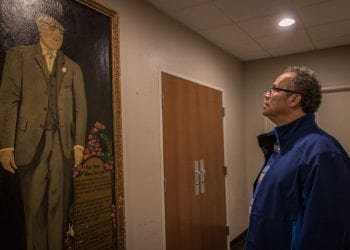
King-Tears Mortuary: A History, 2019-03-07, King-Tears Mortuary
King-Tears Mortuary is the oldest African American funeral home in Austin, TX. Founded by Mr. William Tears (formerly of Weed-Corley-Fish Funeral Home) in 1901, Mr. Tears wanted to open a funeral home that would provide services to African Americans. When he was going to retire, Mrs. Alice Taylor-King moved from Tennessee to Texas in 1933 to continue running it—thus creating the partnership of King-Tears Mortuary, an important staple in African American history in Austin, TX.
-
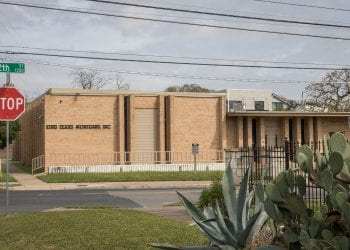
Even in Death, 2019-03-07, King-Tears Mortuary
Mr. Stuart King, the current president and funeral director in charge, states that the reason his mortuary is important is because, in the past, segregation’s limits reached as far as burial laws. In the 19th and early 20th century, Mr. King states that African Americans weren’t allowed to be buried with the other races. Until 1975, when integration reached the cemeteries, African Americans had their own cemeteries that were allotted to them by slave owners. Mr. King shares that this was an unfortunate time in history because “we all go to the same heaven”.
-

Cultural Interpretations of Death, 2019-03-07, King-Tears Mortua
Mr. King discussed our society’s cultural dispositions towards death, analyzing that people in the United States rarely talk about their own mortality. As a taboo topic, he explained that departure from life has become associated with frightening concepts like isolation and separation. He believes that these views are unfortunate, and he wishes that death could be considered a celebration of one’s life, like in the Mexican culture with the Day of the Dead activities and traditions. Mr. King, who often likes to travel to Mexico for these festivities, considers it a beautiful representation of how death should be revered. Through its celebratory style, he reasons, the aforementioned ideas that people in our society correlate with death become removed.
-
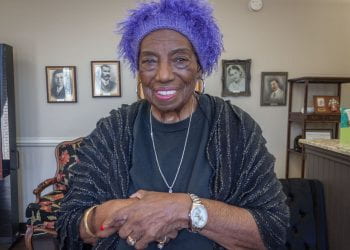
Living Strong, 2019-03-04, King-Tears Mortuary
Eighty-four-year-old Jessie Mercer visited King-Tears Mortuary on March 4th, 2019 to get a document notarized. Whilst waiting, Mrs. Mercer, a family friend to Mr. King, talked to me and two men in the front desk about nothing and everything. She spoke about her life and her accomplishments, like the memoir she wrote in 2005 titled Pilgrimage: The Course of Life on Earth which documents her life and her time working with the City of Austin. She also told us witty yet inspirational anecdotes. For instance, she states that a gentleman she looked up to in life would say: “Put down your hand—no more black power; get some green power. Go to school, put something in your head and get some green power”. She shared with us that she would think of this saying when she was young and looking for a job. Mrs. Mercer is a kind woman with a personable character who loves to play bingo. She describes herself as having “a sound mind and a good understanding”.
-
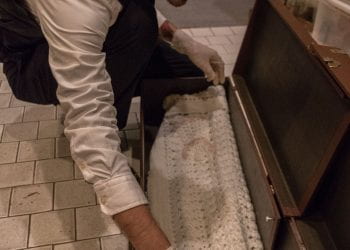
For the Little, 2019-03-07, King-Tears Mortuary
When a loved one has passed, Mr. Martinez’s goal is to help alleviate the griever’s fear. He states that “we are all humans: we all want to be good to each other—to give people security and peace”. He recognizes that it is a hard task to accomplish because the emotions of the job are difficult, but he does try. He explains that when working in this kind of career one has to “lock it down”. He shares that he tries to reason with himself by saying, “this is who I am for the time that I am here”, recognizing that it is important to separate business and personal emotions; however, with children who have passed, Mr. Martinez shares that this becomes very hard to do; he explains: “you end up going home feeling very different”; nonetheless, he states: “you’ve got to remember that if it’s hard for you then you can’t even image what the family is going through”. This thinking, he explains, helps him understand that he has to be strong for them.
-

The Tricks of the Trade, 2019-03-07, King-Tears Mortuary
There are many tools that Mr. King, Mr. Martinez and other part-time embalmers use. An aspirator (far right) is vital for the embalming process because it removes the initial bodily fluids; it has many different attachments for different entrances to the body. For instance, the nasal and oral attachment (left, the long, curved tool with a bulb head) removes liquid that has occupied the nose and mouth; for the abdomen, the attachment is shaped differently (to the right of the nasal attachment, it is more pointed) to gain access to all the fluids left. Mr. Martinez states that removing these fluids is important because the embalming chemicals must occupy their spaces; he also states that it helps reduce the weight of a corpse.
-
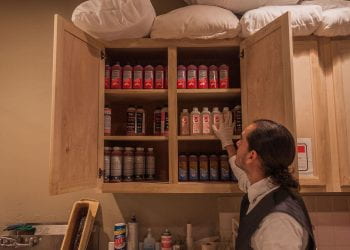
The Cannula, 2019-03-07, King-Tears Mortuary
Another useful tool that they use are called forceps. Some forceps are used to secure the cannula (a tool that is inserted into the artery on one end and that is connected to the embalming machine at the other). When they do this, the embalming machine is then able to pump the chemicals into the body. Mr. Martinez states that the embalming fluid is mostly used for preservation so that the family has time to say goodbye, but it is also used as a disinfectant. He explains that the chemicals help dilute or eliminate spreadable bacteria, like contagious skin necrosis. “It’s a precautionary measure”, he explains.
-
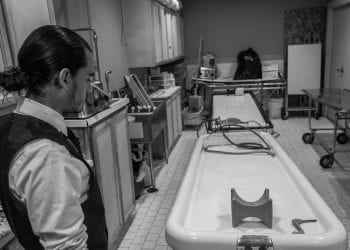
“It’s a Coin Toss”, 2019-03-04, King-Tears Mortuary
When he tells people that he strives to become a licensed mortician, Mr. Martinez has noticed that people will have either one of two reactions. The first, he explains, is that “people will recognize that this job is unpleasant for many reasons, but that it’s a public service that needs to be provided”. He shares that there have been many times where he’s been thanked for his services. On the other hand, he says that there have been times where people have gone pale after learning his profession. He explains: “people have shut down because the reality of death comes too close for comfort”. He also states that people in the hospital will very obviously avoid them; some have even said to him: “Thanks for what you do, but I don’t want to see you”.
-
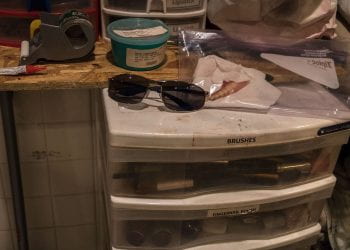
Restorative Art, 2019-03-07, King-Tears Mortuary
In order to become a mortician, one has to take a course on restorative art, which is defined as recreating the natural form and color of a person when they were alive. This is mostly done through cosmetology. Therefore, in addition to knowing the embalming procedures, morticians must know how to contour, create layers, use powders and creams, and style hair.
-

At King-Tears Mortuary, some part-time embalmers enjoy using curling irons, straighteners, and combs to style their clients hair; however, the types of tools they use vary slightly from its traditional counterpart: they use stove top Golden Supreme Irons that seem to be slightly dated but work very well.
-
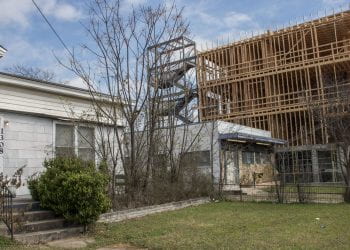
Gentrification surrounds the Mortuary, 2019-03-07, King-Tears Mo
Because his grandmother (Mrs. Alice Taylor-King) lived next door to the mortuary, Mr. King would, as a child, play in the chapel, and his brothers would drive the ambulance service. Mr. King’s upbringing—and the upbringing of his mortuary since 1901—play an important role in the history of Austin’s 12th street (which is now becoming a product of gentrification). Because of this, Mr. King vows to have the City put a historical marker in front of his grandmother’s house. “Before I die”, he says, “I’ll make sure it happens”.
-
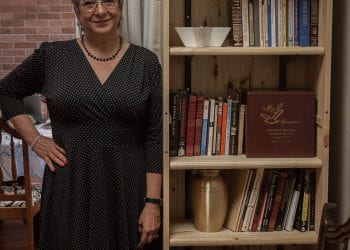
“I wanted to be the change that I wanted to see”, 2019-04-2
Mitzi Chafetz first considered a career in mortuary after an unfortunately rude experience with the funeral home that was providing their services for two of her family members. Since then, she worked at the Texas Funeral Service Commission in Austin, TX for six years. There she learned much about what is required from morticians and the complaints that customers experienced with them. This prompted Mitzi to become a licensed mortician and work for Austin based mortuary, Weed-Corley-Fish Funeral Homes & Cremation services. There she was allowed to discuss natural burial options, a service that she is deeply passionate about, with family members. Since then, she and her husband have gone on to own and maintain a natural burial park in Bastrop County called Eloise Woods. She is also the owner and funeral director at Austin Natural Funerals in Austin, TX.
-
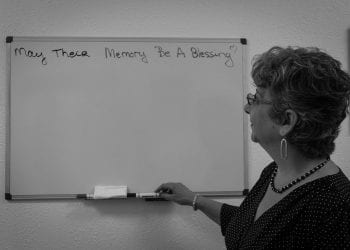
Phobia, 2019-04-29, Austin Natural Funerals
Like Stuart King of King-Tears Mortuary, both Mitzi and Campbell recognize that society is “death-phobic”. People don’t like to speak about death or even acknowledge it. In the beginning, they themselves had a hard time adjusting to their newfound career paths, but they soon realized that this line of work allowed them to be free and live in the moment: “You have too because you have no idea what will happen”, commented Campbell. They are both grateful that they are able to think about death and what they want their lives to mean before it’s too late.
-
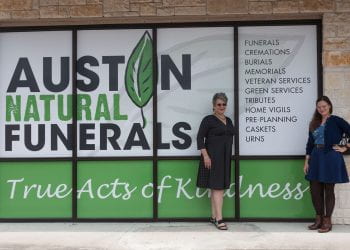
Unrealistic Expectations from Society, 2019-04-29, Austin Natura
When you lose someone close to you, grieving takes time, Mitzi argues. She is upset at the way society treats individuals after a loss, stating that some people are only allowed a three-day-bereavement leave. She exclaims that society takes an unrealistic approach to grief itself: “You’re expected to go to work and go to the store, but it is hard”, she states. Grieving is a lifelong process, and society should be more understanding to family members.
-
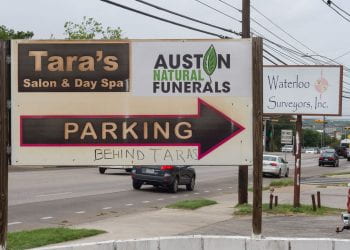
“I wanted to be the change that I wanted to see”, 2019-04-3
Mitzi Chafetz first considered a career in mortuary after an unfortunately rude experience with the funeral home that was providing their services for two of her family members. Since then, she worked at the Texas Funeral Service Commission in Austin, TX for six years. There she learned much about what is required from morticians and the complaints that customers experienced with them. This prompted Mitzi to become a licensed mortician and work for Austin based mortuary, Weed-Corley-Fish Funeral Homes & Cremation services. There she was allowed to discuss natural burial options, a service that she is deeply passionate about, with family members. Since then, she and her husband have gone on to own and maintain a natural burial park in Bastrop County called Eloise Woods. She is also the owner and funeral director at Austin Natural Funerals in Austin, TX.
-
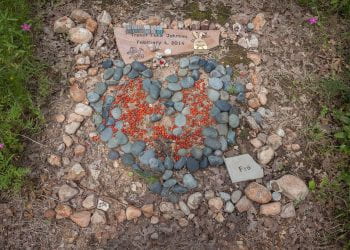
The Emotions of the Job, 2019-04-29, Eloise Woods Natural Burial
Although working in a funeral home permits that one will see many sad or angry family members, both Mitzi and Campbell explain that they have seen a lot of happiness and love too. They try their best to commit themselves to the family’s needs and provide for them a consistent partnership throughout this ordeal.
-
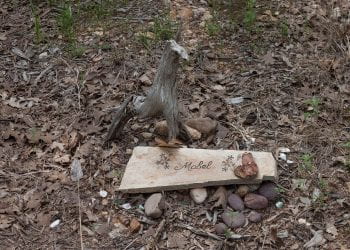
The Only Natural Burial Park in Austin, TX, 2019-04-29, Eloise W
Inspired by her favorite HBO special, Six Feet Under, Ellen MacDonald founded Eloise Woods Natural Burial Park. This park is a green cemetery that offers their services for those who wish to bury a pet or family member in a simple, natural, and sustainable way; this means without the use of embalming chemicals or metal caskets. Instead, loved ones are placed in wooden coffins or wrapped in shrouds made from materials that are environmentally friendly.
-

True Acts of Kindness, 2019-04-30, Austin Natural Funerals
Prior to working at Austin Natural Funerals, Campbell Ringel was working at The Natural Gardener in Austin, TX and would often volunteer her time at Eloise Woods. She explains that spending time at the Woods made her feel content because she was helping people: “It’s rewarding when you help someone through the most hurtful of times”, she states. And so, after being offered a position at Austin Natural Funerals by Mitzi, Campbell decided to seek a degree in Mortuary Science and become a funeral director.
-

Trails of Remembrance, 2019-04-30, Eloise Woods Natural Burial P
When family members visit their loved ones, they walk on trails with unique names created by Ellen, such as Rainbow Bridge, Sweet Angel Garden, Purple Heart Trail, and Teva garden, to name a few. The different sections and names represent who is buried there, such as animals, children, war veterans, and people of the Jewish community. Visitors can also see sculptures or signs that represent those individuals, as well. For instance, Ellen created wooden sculptures and rock engravings to represent these sections in an artistic manner.
-
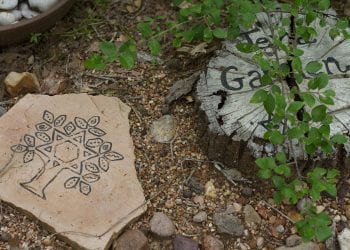
Trails of Remembrance, 2019-04-30, Eloise Woods Natural Burial P
When family members visit their loved ones, they walk on trails with unique names created by Ellen, such as Rainbow Bridge, Sweet Angel Garden, Purple Heart Trail, and Teva garden, to name a few. The different sections and names represent who is buried there, such as animals, children, war veterans, and people of the Jewish community. Visitors can also see sculptures or signs that represent those individuals, as well. For instance, Ellen created wooden sculptures and rock engravings to represent these sections in an artistic manner.
-
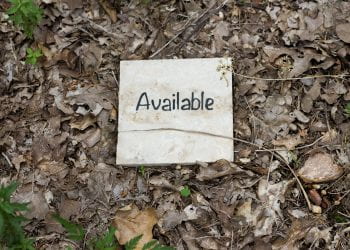
Phobia, 2019-04-30, Eloise Woods Nautral Burial
Like Stuart King of King-Tears Mortuary, both Mitzi and Campbell recognize that society is “death-phobic”. People don’t like to speak about death or even acknowledge it. In the beginning, they themselves had a hard time adjusting to their newfound career paths, but they soon realized that this line of work allowed them to be free and live in the moment: “You have too because you have no idea what will happen”, commented Campbell. They are both grateful that they are able to think about death and what they want their lives to mean before it’s too late.
-
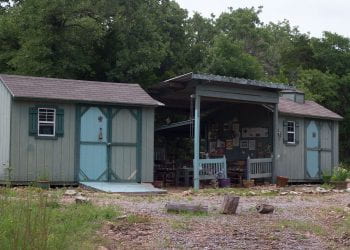
The Only Natural Burial Park in Austin, TX, 2019-04-30, Eloise W
Inspired by her favorite HBO special, Six Feet Under, Ellen MacDonald founded Eloise Woods Natural Burial Park. This park is a green cemetery that offers their services for those who wish to bury a pet or family member in a simple, natural, and sustainable way; this means without the use of embalming chemicals or metal caskets. Instead, loved ones are placed in wooden coffins or wrapped in shrouds made from materials that are environmentally friendly.
-
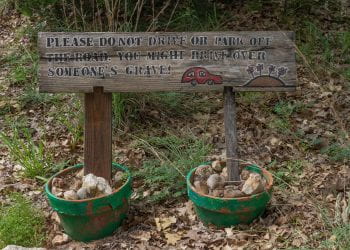
The Only Natural Burial Park in Austin, TX, 2019-04-30, Eloise W
Inspired by her favorite HBO special, Six Feet Under, Ellen MacDonald founded Eloise Woods Natural Burial Park. This park is a green cemetery that offers their services for those who wish to bury a pet or family member in a simple, natural, and sustainable way; this means without the use of embalming chemicals or metal caskets. Instead, loved ones are placed in wooden coffins or wrapped in shrouds made from materials that are environmentally friendly.
-
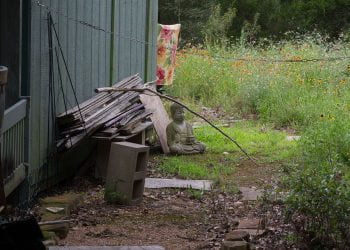
Trails of Remembrance, 2019-04-30, Eloise Woods Natural Burial P
When family members visit their loved ones, they walk on trails with unique names created by Ellen, such as Rainbow Bridge, Sweet Angel Garden, Purple Heart Trail, and Teva garden, to name a few. The different sections and names represent who is buried there, such as animals, children, war veterans, and people of the Jewish community. Visitors can also see sculptures or signs that represent those individuals, as well. For instance, Ellen created wooden sculptures and rock engravings to represent these sections in an artistic manner.
-
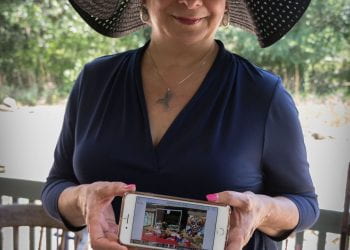
Celebrating Life Cross-Culturally, 2019-04-28, Eloise Woods Natu
After discussing how other cultures treat their dead, such as in Mexico with their Day of the Dead festivities, Mitzi stated that they celebrate Dia de los Muertos every year at Eloise Woods. During that time, families are allowed to come out and decorate their loved ones’ plots and celebrate their life. Mitzi and her husband decorate the land with sugar skulls and papel picado to represent traditional Day of the Dead customs.
-
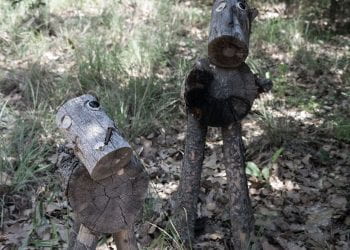
Trails of Remembrance, 2019-04-28, Eloise Woods Natural Burial P
When family members visit their loved ones, they walk on trails with unique names created by Ellen, such as Rainbow Bridge, Sweet Angel Garden, Purple Heart Trail, and Teva garden, to name a few. The different sections and names represent who is buried there, such as animals, children, war veterans, and people of the Jewish community. Visitors can also see sculptures or signs that represent those individuals, as well. For instance, Ellen created wooden sculptures and rock engravings to represent these sections in an artistic manner.
-
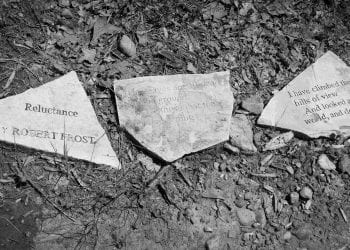
Trails of Remembrance, 2019-04-28, Eloise Woods Natural Burial P
When family members visit their loved ones, they walk on trails with unique names created by Ellen, such as Rainbow Bridge, Sweet Angel Garden, Purple Heart Trail, and Teva garden, to name a few. The different sections and names represent who is buried there, such as animals, children, war veterans, and people of the Jewish community. Visitors can also see sculptures or signs that represent those individuals, as well. For instance, Ellen created wooden sculptures and rock engravings to represent these sections in an artistic manner.
-
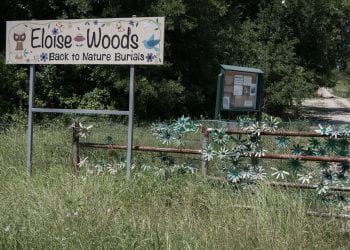
The Only Natural Burial Park in Austin, TX, 2019-04-28, Eloise W
Inspired by her favorite HBO special, Six Feet Under, Ellen MacDonald founded Eloise Woods Natural Burial Park. This park is a green cemetery that offers their services for those who wish to bury a pet or family member in a simple, natural, and sustainable way; this means without the use of embalming chemicals or metal caskets. Instead, loved ones are placed in wooden coffins or wrapped in shrouds made from materials that are environmentally friendly.